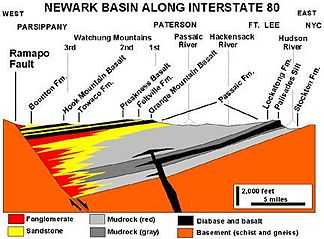Graben


In geology, a graben is a depressed block of land bordered by parallel faults. Graben is German for ditch or trench. The plural form is variously given as graben[1] or grabens.[2]
A graben is the result of a block of land being downthrown producing a valley with a distinct scarp on each side. Graben often occur side-by-side with horsts. Horst and graben structures are indicative of tensional forces and crustal stretching.
Graben are produced from parallel normal faults, where the hanging wall is downthrown and the footwall is upthrown. The faults typically dip toward the center of the graben from both sides. Horsts are parallel blocks that remain between graben; the bounding faults of a horst typically dip away from the center line of the horst.
Single or multiple graben can produce a rift valley.
One of the world's deepest graben with over 1000 metres of downthrow is the Mount Unzen volcanic complex in southern Japan.
Half-graben

In many rifts the graben are asymmetric, with a major fault along only one of the boundaries, and these are known as half-graben. The polarity (throw direction) of the main bounding faults typically alternate along the length of the rift. The asymmetry of a half-graben strongly affects syntectonic deposition. Comparatively little sediment enters the half-graben across the main bounding fault, due to the effects of footwall uplift on the drainage systems. The exception is at any major offset in the bounding fault, where a relay ramp may provide an important sediment input point. Most of the sediment will enter the half-graben down the unfaulted hanging wall side (e.g. Lake Baikal).[3]

Prominent graben
- The Basin and Range Province of southwestern North America is an example of multiple horst/graben structures, including Death Valley, with Salt Lake Valley being the easternmost and Owens Valley being the westernmost.
- The Rio Grande Rift Valley in Colorado/New Mexico/Texas of the United States
- The Rhine valley to the north of Basel, Switzerland
- The Oslo graben around Oslo, Norway
- The East African Rift Valley
- The Saguenay Graben, Quebec, Canada
- The Narmada River valley in central India
- The lower Godavari River valley in southern India
- The Ottawa-Bonnechere Graben in Ontario and Quebec, Canada
- The Lambert Graben in Antarctica
- Gulf St Vincent in South Australia, Australia
- The Guanabara Bay in Rio de Janeiro, Brazil
- The Central Lowlands (Midland Valley) of Scotland
- Baikal Rift Zone, Siberia, Russia
- Lake Tahoe, California and Nevada, U.S.A.
Other graben
- The Republic Graben in Republic, Washington
- The Log Hill Graben in Ouray County, Colorado
Notes
- ↑ Schlumberger Oilfield Glossary
- ↑ "horst and graben". Encyclopedia Britannica. Retrieved 2012-11-15.
- ↑ Nelson,C.H., Karabanov,E.B., Colman,S. and Escutia,C. 1999, Tectonic and sediment supply control of deep rift lake turbidite systems: Lake Baikal, Russia. Geology, 27, 163–166
References
- McKnight, Tom L; Hess, Darrel (2000). "The Internal Processes: Graben". Physical Geography: A Landscape Appreciation. Upper Saddle River, NJ: Prentice Hall. p. 417. ISBN 0-13-020263-0.